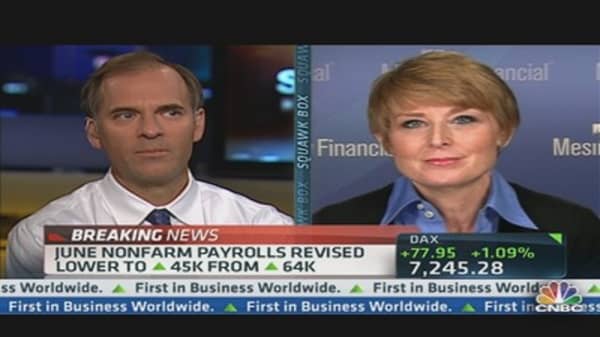Employment growth remained weak in August, with just 96,000 new positions created but the unemployment rate dropped to 8.1 percent, according to a report that raises the possibility of more Federal Reserve easing.
The decline in the jobless rate, from 8.3 percent in July, came primarily because the labor force participation rate fell to 63.5 percent, its worst level in more than 30 years — since September 1981. The civilian labor force contracted by 368,000.
A more encompassing measure of unemployment, which counts those not looking for jobs, fell to 14.7 percent from 15.0 percent in July.
But job reports for June and July were revised lower. The June count fell from 64,000 to 45,000, while July's number came in at 141,000 from an originally reported 163,000.
"The unemployment rate remains elevated, and the duration of joblessness is unprecedented for many," said Kathy Bostjancic, director of macroeconomic analysis at The Conference Board. "These conditions could easily stretch into the early months of 2013."
The Labor Department's birth-death model, which approximates jobs created by new businesses during the month, added 87,000 to the total, making it primarily responsible for the net job gains.
Despite hopes that job creation would be better than expected, the monthly nonfarm payrolls report fell short of economist estimates that 125,000 jobs were added for the month. The government said private payrolls increased by 103,000, about half the 201,000 that ADP reported Thursday.
Service sector positions again dominated the new jobs, and manufacturing lost positions.
The news momentarily dampened spirits on Wall Street, with stock futures losing earlier gains and indicating a flat open for the market.
But the report could lift hopes that the Fed will step in with a third round of quantitative easing, a program in which the central bank buys government debt in hopes of driving down interest rates and pushing investors to riskier assets.
Stocks opened mixed, though the Labor Department report offered few positive signs that the jobs market was turning around.
"We remain optimistic that the Fed will next week unleash a further balance sheet expansion given the ongoing slog in the labor market," said Andrew Wilkinson, chief economic strategist at Miller Tabak in New York. "To that extent, bad economic news is good and the rally in risk assets should continue."
In addition to the move in stocks, gold prices surged to their highest level since March — other metals also posted sharp gains — and the 10-month Treasury yield fell to 1.62 percent on expectations of more bond buying.
Restaurants and bars added 28,000 positions to set the job-creation pace. Professional and technical services added 27,000 jobs, while health care rose 17,000, computer systems gained 11,000 and management and consulting increased by 9,000.
"Leisure and hospitality jobs are gaining. That's a good thing," said John Canally investment strategist and economist at LPL Financial. "That means people are out there spending, doing things they don't have to do."
Canally said the report offered a safe middle ground for investors: Not bad enough to trigger fears of another steep 2008-style recession, but worrisome enough to generate Fed action.
"We're just not growing fast ehough," he said. "That means more signals for the Fed."
Manufacturing lost 15,000 for the month, due primarily to auto manufacturers who both laid off and recalled fewer workers this summer.
Average hourly earnings were basically flat at $23.52 an hour, as was the work week at 34.4 hours.
Long-term unemployment problems persisted, with the average time without a job rising to 39.2 weeks
The report comes at a critical time in the election cycle, with President Obama and Republican Mitt Romney in a virtual dead-heat and the final vote just two months away. (Read More: Record 46 Million Americans Are on Food Stamps)
Romney has criticized the president for the lackluster level of job creation as the unemployment rate has stayed above 8 percent for a record 43 consecutive months. Obama has countered that his administration has created more than four million jobs, though the net level of job creation is much lower.
"It's important to take a step back, take today's report into context with other information coming in, recent reports" Alan Krueger, chairman of Obama's Council of Economic Advisors, told CNBC. "We see a pattern that the economy is continuing to heal from the very deep recession that struck at the end of 2007 and really came to a boil in 2008."
Employment growth has averaged 139,000 per month in 2012, though the first quarter was much stronger due to spillover effects from the mild winter.





